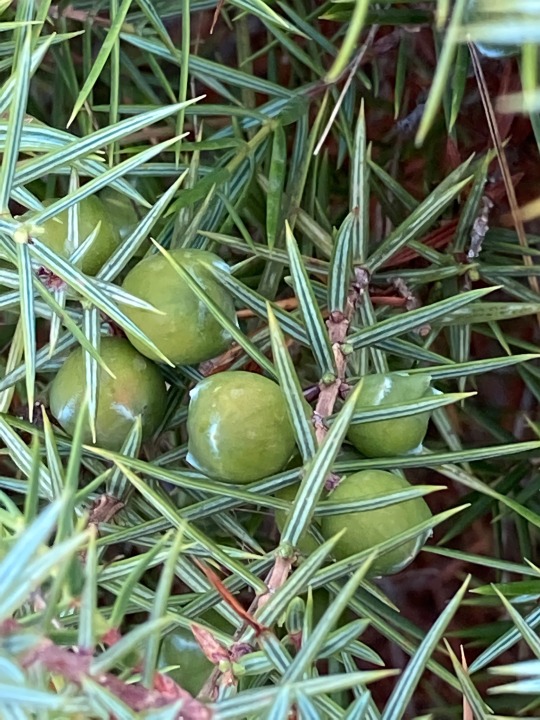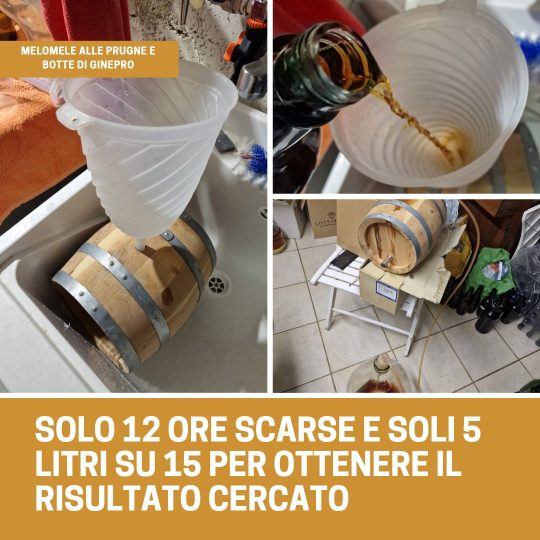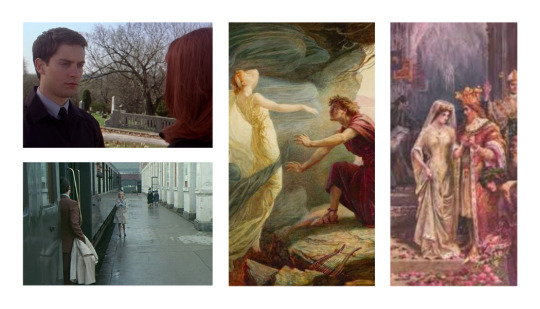#Ginepro
Photo

Come realizzare ed utilizzare uno smudge stick
Come abbiamo detto nel post precedente (https://at.tumblr.com/phaetontheswan/che-cos%C3%A8-uno-smudge-stick-lo-smudge-stick-o/ut9q07rukm59), la scelta degli ingredienti andrebbe basata sul rispetto di tutte le usanze, motivo per il quale sarebbe meglio sostituire piante come la salvia bianca con della salvia comune e il cedro con il ginepro per esempio, per non andare incontro all’appropriazione culturale nei confronti di altre tradizioni. Detto ciò, la realizzazione si divide in:
Raccolta: la pianta va colta fresca; le foglie vanno tagliate solo nella parte superiore della pianta, tralasciando lo stelo e cercando di non scuotere troppo la pianta in modo da non scuotere i fiori e non far cadere i semi.
Legatura: le piante vanno unite formando dei cilindri che vanno dai 10 ai 15 cm di lunghezza, scelte in base allo scopo e legate con dello spago o del filo di origine naturale.
Essicazione: i cilindri creati andranno fatti essiccare per una settimana a testa in giù; se l’essicazione avviene all’aperto, la notte sarà necessario coprirli o in alternativa spostarli al chiuso.
A questo punto gli smudge sticks saranno pronti per essere accesi, preferibilmente con dei fiammiferi, ed utilizzati per i nostri rituali.
#Divinazione#Erbe aromatiche#Erbe officinali#Ginepro#Guarigione#Meditazione#Primavera#Purificazione#Salvia comune#Smudging#Smudge stick#Smudge sticks
7 notes
·
View notes
Text

Bacche di ginepro. Nella mia lingua.."zinnivuru".
47 notes
·
View notes
Photo

(via Collezione Gin J.Rose)
Un London dry raffinato nella formula e nel pack, impreziosito dalle illustrazioni di Milo Manara, che nasce dalla perfetta fusione tra tradizione distillatoria, artigianato e arte. Per regalare un’esperienza unica
Frutto di un connubio perfetto tra arte, artigianato e distillazione, J.Rose Gin è un London dry che celebra l'eccellenza italiana sotto tutti i punti di vista. Ma è anche un prodotto che ha alle spalle una storia affascinante.
---------------------------------------------------------------------------------
#ginjrose#gintonic#minomanata#arte#martinicocktail#bartender#barman#moda#tentenza#ginepro#fashiongin#gintour#bartime#barschool#formazione#distillato#artgin#buongin#collezionegin#collezionejrose#collezionemanara
0 notes
Photo

Oggi al lavoro con la mia #mascotte Ho preso un #idromele annuale che mi diceva poco... e allora... ho aggiunto la #tintura di 3 diversi #peperoncini e poi sono andato ad #affumicare con legna di #ginepro Poi farò un bel #travaso e un #backsweetening con #sciroppodacero e aggiusterò i precedenti sapori per riequilibrare #icoloridellidromele #batino #mead #honey #casaparrini #miele #pazzomele (presso Siena, Italy) https://www.instagram.com/p/Cnb3QTHtj77/?igshid=NGJjMDIxMWI=
#mascotte#idromele#tintura#peperoncini#affumicare#ginepro#travaso#backsweetening#sciroppodacero#icoloridellidromele#batino#mead#honey#casaparrini#miele#pazzomele
0 notes
Text
Clima: mai così poca neve sulle Alpi!

Durata del manto nevoso e cambiamento climatico vanno a braccetto da secoli
Nell'ultimo secolo la persistenza della neve si è ridotta di oltre un mese sulle Alpi. Si va a segnare così il record negativo dai tempi di Cristoforo Colombo e Leonardo da Vinci.
Queste le conclusioni di uno studio realizzato da un gruppo di ricerca dell’Università di Padova e dell’Istituto di scienze dell’atmosfera e del clima (ISAC) del Consiglio nazionale delle ricerche (CNR) di Bologna e pubblicato sull’autorevole rivista scientifica Nature Climate Change.
Lo studio condotto Marco Carrer, Raffaella Dibona e Angela Luisa Prendin, dell’università di Padova, e da Michele Brunetti, dell’Istituto di Scienze dell'Atmosfera e del Clima del Consiglio Nazionale delle Ricerche (Isac – Cnr) ha analizzato lo spessore degli anelli di accrescimento del ginepro determinando il numero dei giorni nei quali le piante hanno interrotto la loro crescita a causa della copertura nevosa.
Abbiamo scoperto che un arbusto estremamente diffuso, il ginepro comune, quando si trova in alta quota ha un portamento strisciante sul terreno, ovvero cresce orizzontalmente molto vicino al suolo, ed è in grado di registrare nei suoi anelli di accrescimento la durata della copertura nevosa” spiega Marco Carrer dell’Università di Padova e primo autore dello studio. “Infatti, essendo alto poche decine di centimetri, la sua stagione di crescita dipende fortemente da quanto precocemente riesce ad emergere dalla coltre bianca che lo ricopre”.
Lo studioso poi prosegue affermando che
Per la prima volta siamo riusciti a ricostruire la durata del manto nevoso su quasi tutto l'arco alpino italiano degli ultimi 600 anni" Ne emerge che tra un anno e l'altro ci sono fluttuazioni importanti, ed è normale che sia così, ci sono dei periodi un po' più lunghi che si discostano dalla media ma il dato molto evidente è che tra il 1400 e il 1900 siamo stati su livelli più o meno stabili ora invece, da diversi decenni si assiste a una costante discesa.
Michele Brunetti dell’Istituto di Scienze dell'Atmosfera e del Clima del Consiglio Nazionale delle Ricerche
E' "come se le Alpi si fossero abbassate di quasi 300 metri.A 2.000 metri la durata della neve oggi è come quella che si registrava qualche decennio fa a 1.700 metri!"
Studiare la persistenza della neve consente di misurare di fatto i "serbatoi" che garantiscono l'approvvigionamento d'acqua anche nei periodi caldi e senza piogge.
Da qui la necessità di sviluppare strategie di adattamento per alcuni dei settori ambientali e socioeconomici più sensibili.
Lo studio completo può essere consultato direttamente sul sito di "Nature Climate Change"
Read the full article
0 notes
Text

Ginepro bus sketch
99 notes
·
View notes
Text
Willkommen im Restaurant Nero Ginepro
Willkommen im Restaurant Nero Ginepro
Im Ristorante Nero Ginepro, wo die Tradition zur Inspiration für neue Vorschläge wird, können Sie das Zusammentreffen von Neuem und Altem genießen, während Sie auf der neuen Website einen Blick auf die Gerichte und das gemütliche Ambiente werfen können.
Besuchen Sie die Website hier: neroginepro.ch

View On WordPress
#siti internet#italiano#ristorante nero ginepro#ticinoweb#web design#web designer#sito web ristoranti
0 notes
Photo

Holidays in Orosei. Camping Cala Ginepro Services
Holidays in Orosei. Camping Cala Ginepro Services. Read more, plus the other latest top camping & glamping stories and news in today's edition of "Camping News" ▸ https://campingholidaysites.com/?edition_id=da9a3390-ef25-11ec-9d70-fa163ed80008
0 notes
Text
Ed era verde e d’oro la vallata…
Ed era verde e d’oro la vallata…
Disegno a matita su taccuino: di Ennio Contini – Fonte: http://www.apice.unimi.it
Del resto la vena religiosa di Contini era emersa già dalla prima raccolta, Magnolia, ma è con L’Alleluja che raggiunge il coronamemento di un percorso spirituale più profondo e complesso, legato a doppio filo alla sua reclusione. Costretto entro i limiti di una cella Contini cercava nella fede e nella spiritualità…

View On WordPress
#1952#1953#Alleluja#Antonio Conio#Ennio Contini#Ezra Pound#Fra Ginepro#Francesca Bergadano#Italo Cremona#Magnolia#Olivia Rossetti Agresti#Pio Cappuccino#poesia#Pompeiana#Renzo Laurano#Salvatore Rosati
0 notes
Text

Lorenzo di Credi (Italian, 1459-1537)
Portrait of a Young Woman, ca.1490-1500
The Metropolitan Museum of Art
This damaged but evocative portrait has been identified as the widow of the artist's brother, who was a goldsmith. This would explain why she is dressed in black and holds a ring. The juniper bush (ginepro) behind her could refer to her name, Ginevra di Giovanni di Niccolò. The picture was inspired by Leonardo's portrait of Ginevra de' Benci in the National Gallery of Art, Washington.
#art#western civilization#italy#southern europe#european#italian#italian art#cradle of civilization#fine art#fine arts#oil painting#woman#female portrait#female#portrait#classical art#1400s#1500s#Lorenzo di Credi#european art#europe#mediterranean#europa#brown eyes
47 notes
·
View notes
Text
Le donne che vanno in giro di notte senza cercare un uomo
o un letto con dentro un uomo, o uno sguardo complice o il complice di uno sguardo.
Le donne che si bastano e sanno bastarsi,
che se vagano lo fanno per vagare e non per farsi trovare,
tuttalpiù per far perdere le loro tracce,
le donne sazie del resto, ma mai di loro stesse.
Le donne che cercano di precedere la loro angoscia,
prendendo l’ultimo sgabello in fondo a sinistra, quello in curva, il più tranquillo,
nel buio screziato d’anice, nel riflesso ramato del bancone,
nell’asse perfetto culo – pavimento.
Quelle donne, nel loro silenzio personale, nell’asperità di un sogno,
nel qualunquismo disperato di un’idea forse comune,
nell’introspezione inutile, nell’affanno di un disagio
e nel metro quadro di un’ipotesi azzardata.
Le donne come me, come te e come altre che non sanno dove collocarsi,
ecco, a queste donne dedico la voce roca di un buongiorno d’erba,
ginepro e tabacco,
dove ci vorrebbe un piano suonato in lontananza per non sentirsi fuori posto,
dove il mondo dovrebbe trovare un’altra voce per il suo vocabolario:
né amanti, né spose, né depresse e né puttane.
Ah sì, ci vorrebbe un fischio di un panettiere in bicicletta,
una chanson française, un aforisma, una frase perfetta.
Ci vorrebbe un riparo.
In certe mattine petrolio dove il caldo fa affogare i tacchi
e dove le case per rientrare sembrano sempre troppo lontane.
.
Cecilia Resio, Bar
42 notes
·
View notes
Photo

Che cos’è uno smudge stick?
Lo smudge stick o incenso sciamanico è uno dei principali strumenti utilizzati sia in oriente che in occidente nei rituali di purificazione; i suoi fumi densi e pregni di profumi aromatici hanno sempre avuto una connotazione mistica tanto da essere utilizzati nelle cerimonie di diversi credi religiosi. Piante e fiori essiccati, resine, legno ed erbe aromatiche sono i componenti che lo costituiscono. La pratica del fumo purificatore trova spazio in diverse culture del mondo, le quali si differenziano dalle piante sacre che vengono impiegate nel rito e dallo scopo per il quale vengono utilizzate; per questo motivo, prima di avvicinarsi a questa pratica, è bene sapere alcune cose per agire nel completo rispetto delle culture. Come spesso ci capita di vedere, molti smudge sticks sono stati realizzati utilizzando materiali come la salvia bianca e il palosanto ma questi due ingredienti sono tipici dei rituali nativo americani e che di fatto, l’utilizzo di questi, comporterebbe l’appropriazione culturale di questi popoli oltre al grande problema emerso negli ultimi anni, ovvero che l’abuso di questi materiali da parte di persone che non parte di queste tradizioni sta portando all’esaurimento la quantità disponibile, facendo temere che presto sarà in pericolo o estinta.
Detto ciò, ci sono moltissime varietà di piante, fiori e di legno che sono ottimi sostituti per questo rito anche qui in Europa, ecco alcuni esempi:
Alloro: ha proprietà antibatteriche, antisettiche, riscaldanti e dona vitalità; è un simbolo di divinazione, successo e saggezza.
Artemisia: aiuta anche a connettersi con i propri sogni per questo è utile bruciarla prima di andare a dormire perché concilia il sonno; è un simbolo di divinazione e profezia ed è utilizzata per la meditazione e per la preghiera; ha un ottimo effetto purificante dopo la febbre stagionale e il ciclo mestruale.
Ginepro: ottimo contro la stanchezza fisica e mentale e per il suo grande potere purificante.
Lavanda: ha proprietà rinfrescanti e rilassanti, dona energia e calma la psiche e il corpo oltre ad essere un simbolo di amore, guarigione e pace.
Rosa: stimola l’empatia e aiuta il cuore ad aprirsi all’amore.
Rosmarino: aumenta la concentrazione, stimola l’empatia, la memoria e dà chiarezza mentale permettendo di discernere il buono dal cattivo oltre ad essere un simbolo di guarigione, saggezza, salute e di protezione.
Salvia (mediterranea): ha proprietà antibatteriche, per questo viene utilizzata per purificare ambienti e persone in quanto ha un effetto positivo sugli stati emotivi e sull’intuizione ed è utilizzata per la meditazione e per la preghiera.
Pino: ha proprietà balsamiche e sedative, dona energia, protezione dagli altri, sicurezza e purifica gli ambienti dalle negatività.
Il periodo migliore per la raccolta è a maggio e durante l’arco estivo per le piante aromatiche, quando le piante sono all’apice della loro maturazione e quindi del loro potere visto la quantità di olii essenziali è maggiore. Una volta raccolte si dovrà procedere alla legatura quindi all’essicazione.
#Alloro#Artemisia#Divinazione#Erbe aromatiche#Erbe officinali#Estate#Ginepro#Guarigione#Lavanda#Meditazione#Olii essenziali#Pino#Preghiera#Primavera#Purificazione#Rosa#Rosmarino#Salvia#Smudging#Smudge stick#Smudge sticks
0 notes
Text


J – Juniperus communis L. – Ginepro comune (Cupressaceae)
J – Juniperus oxycedrus L. – Ginepro ossicedro (Cupressaceae)
34 notes
·
View notes
Text
Fast aging
Ah la #botticella di #ginepro che libidine che è. Da dei sentori eccezionali in pochissimo tempo. La ho riempita con un terzo del #melomele alle #prugne e la ho tenuta piena solo per poco meno di 12 ore. Domani assembliamo ma se il mio #palato non mi tradisce direi ci siamo proprio. Ci sarà solo da aspettare! #icoloridellidromele #batino #mead #idromele #miele #pazzomele #casaparrini…

View On WordPress
#batino#botticella#CasaParrini#essenza#ginepro#icoloridellidromele#Idromele#mead#Miele#palato#PazzoMele#prugne#succodiprugne
0 notes
Note
Hi , I hope you are doing well. I just want to ask, you have mentioned in one of your post Ginny's name symbolic for hinny being soulmates. please elaborate on that bit.
Thank u
Let's clarify something, I've never said this. I want it to be put on record.
[Also, thank you, I hope you are well, too]
What I did say is that soulmates dynamics usually rely heavily on symbolism. Because soulmates are not a proven real thing, unless they exist explicitly in the worldbuilding of the story, the author uses symbolism to communicate with the reader that yes, they are very conscious of what they are writing, it's written on purpose, those characters are meant for each other. Symbolism is also the literary translation of fate and destiny, obviously essential elements when talking about soulmates. Clearly, the whole symbolic level of narration means nothing in terms of the soulmates storyline if the dynamic of the couple doesn't support it (Harry and Ginny's one does).
Now, one of the many symbolic elements in Harry and Ginny's story is Ginny's name.
Let's see why.
Ginny's full name is Ginevra, an Italian name that comes from the ancient Welsh name Gwenhwyfar. Ginevra means bright spirit, or even bright elf (if someone is in the mood to write a LotR hinny AU).
Ginny throughout the series is often associated with light and warmth, both on a direct level and on a more metaphorical one, and in the last book, she is even directly described as a brilliant light. She Harry's light, she is life itself.
Therefore Ginny's name fits perfectly into the whole symbolic system around her character, a character who is actually one of the main columns of the symbolic system of the entire saga.
It doesn't end here, though.
Ginevra is the Italian version of the name Guinevere.
Guinevere happens to be the wife of King Arthur. The Arthur hero of the legend, like our Harry.
But here is when it gets interesting.
Guinevere is also pretty famous for having cheated on Arthur, this is the complete opposite of Ginny who has been devoted to Harry since before they even met in a way. Ginny has always loved Harry, even when she really didn't want to, and will always love him.
Does this mean that calling Harry's future wife Ginevra was a poor choice?
No.
Referencing a famous story, using it as a trope if you will, but then changing the ending is something that Rowling does on more than one occasion and various times specifically with Harry and Ginny.
Ginny running after the train and Harry looking at her in PS is reminiscing of many love stories, but instead of being a painful goodbye with a promise of a reunion, it's a hello. It's the first time they meet.
Harry saving Ginny from the Chamber is a situation built in a way that strongly references Orpheus and Eurydice but Harry, unlike Orpheus, manages to actually save Ginny.
In the break-up scene between Harry and Ginny, you can see the usual pattern of the hero breaking up with the love of their life because they consider themselves too dangerous, but usually what happens is that the hero lies about their own feelings in order to make sure the love interest stays away, a White Fang situation if you will. A type of scene that is reminiscent of the ending of the highly successful first Spider-Man movie (that came out only three years before HBP and might have easily influenced JKR) where Peter refuses MJ, and at a funeral of all moments. But with Harry and Ginny, Rowling once again adds her own twist. Harry doesn't lie to Ginny, he is extremely honest about his reasons and emotions, and even the things he can't tell her are things that Ginny already knows even if not in detail (that he's going after Voldemort).
In conclusion, Ginevra is definitely a name chosen very carefully. You can like it or not, but Harry and Ginny's story is one of the most clearly meticulously crafted dynamics of the series.

Fun fact: the Italian version of the name is also associated with the juniper (ginepro in Italian). The juniper in many cultures - from the ancient Greek to the Celtic one - is linked to magic and protection (Ginny is a powerful witch, and one of her arcs is her being a protector of others). Particularly in Mesopotamian mythology, it was the plant of the goddess Ištar, goddess of sex and war, who could bring death and destruction but also love and fertility (Ginny's character is basically a delicate balancing act between harshness and sweetness). To add to this, her animal was the lion (Ginny is a leo).
#this is the most nerdish thing I've ever written#harry potter#ginny weasley#harry x ginny#hinny#arthur and guinevere#peter and mj#orpheus and eurydice#thegirlwhowrites642HPmeta
107 notes
·
View notes
Text

"Ginevra de' Benci stands before us in a vision of impenetrable melancholy... Leonardo gives her features a peculiar and pensive sweetness." - Walter Isaacson, "Leonardo da Vinci"
Ginevra de' Benci was a 15th-century Italian noblewoman and the subject of a famous portrait by the renowned artist Leonardo da Vinci. Born in 1457 into the aristocratic de' Benci family in Florence, Italy, Ginevra is best known for her portrait, commonly referred to as the "Ginevra de' Benci."
Leonardo's sitter, the daughter of Florentine banker Amerigo Benci, was first identified by the attribute that matches the name Ginevra: the ginepro or juniper tree placed prominently behind her head, and repeated on the reverse side of the panel as a juniper sprig within an emblematic design. The painting's attribution to Leonardo and the sitter's identification have long been secure.
The portrait depicts Ginevra in a three-quarter pose, showing her face and upper body. She is portrayed with a serene expression and is shown against a landscape background. One unique feature of the portrait is the presence of a juniper tree in the background, which is a visual pun on Ginevra's name, as "ginepro" means juniper in Italian. It is characterized by Leonardo's mastery of details, particularly in the rendering of Ginevra's face and the meticulous representation of textures and patterns in her clothing. It showcases Leonardo's early use of sfumato, a technique that creates a soft and hazy effect by blending tones and colors.
Ginevra de' Benci's life beyond the portrait is relatively obscure. She was married to Luigi di Bernardo Niccolini, a Florentine aristocrat, and later became involved in the literary and artistic circles of Florence. Ginevra was known for her beauty and intelligence, and she was the subject of sonnets and poems by prominent writers of the time.
#ginevra de benci#perioddramaedit#history#edit#italiansedit#italian renaissance#italian architecture#donne italiane#renaissance italy#daisy ridley#donne nella storia#donne della storia#donneitaliane#women of renaissance#renaissance women#renaissance#imedici#leonardo la serie#leonardo da vinci#art#art history#leonardo rai#15th century#women of history#women in history#amerigo benci#benci#florence#rinascimento#Ginevra
22 notes
·
View notes